Response of a Structure Isolated by a Coupled System Consisting of a QZS and FPS Under Horizontal Ground Excitation
Abstract
1. Introduction
2. Equation of Motion
2.1. Equation of Motion for the Case of Quasi-Zero Stiffness
- the weight of the base;
- : the reaction of the ground due to the load of the building;
- : the inherent damping force of the base conferred on it by the various materials of which it is made;
- : the force of the non-linear elastic damper;
- : the elongation force of the structure imparted by the steel;
- : the acceleration felt at the base (foundation);
- mb: the mass of the base above the isolation system;
- : the damping ratio of the non-linear damper to that of the structure;
- : the ratio of the stiffness of the damper structure to that of the structure.
2.2. Equation of Motion for the Case of Quasi-Zero Stiffness Coupled to the FPS
- the weight of the base;
- : the reaction of the ground due to the load of the building
- : the inherent damping force of the base conferred on it by the various materials from which it is made;
- : the force of the non-linear elastic damper;
- : the force of the double FPS;
- : the elongation force of the structure conferred on it by the steel;
- : the acceleration felt at the base (foundation);
- mb: the mass of the base above the isolation system;
- : the ratio of the damping coefficient of the non-linear damper to that of the structure;
- : the ratio of the stiffness of the damper to that of the structure;
- : the sliding friction coefficient;
- : the stiffness constant of the structure;
- : the stiffness constant of the non-linear damper;
- : the maximum value of the coefficient of friction.
2.3. Case of Stochastic Excitation
3. Results and Discussion
3.1. Amplitude–Frequency Response in the Case of a Harmonic Signal
3.2. Amplitude Response for the Case of a Stochastic Signal
3.2.1. Case of Soft Ground
3.2.2. Case of Hard Ground
3.3. Discussion
3.3.1. Case of a Harmonic Signal
3.3.2. Case of a Stochastic Signal
4. Conclusions
Author Contributions
Funding
Data Availability Statement
Acknowledgments
Conflicts of Interest
References
- Snowdon, J.C. Vibration isolation: Use and characterization. J. Acoust. Soc. Am. 1979, 66, 1245–1274. [Google Scholar] [CrossRef]
- Alabuzhev, P.M. Vibration Protection and Measuring Systems with Quasi-Zero Stiffness; CRC Press: Boca Raton, FL, USA, 1989. [Google Scholar]
- Gudainiyan, J.; Gupta, P.K. A comparative study on the response of the L-shaped base isolated multi-storey building to near and far field earthquake ground motion. Forces Mech. 2023, 11, 100191. [Google Scholar] [CrossRef]
- Hui, Y.; Zhou, T.; Liu, J.; Jia, H.; Zhang, S. Seismic response study of multi-span continuous beam bridges near faults considering permanent displacement attenuation effects. Structures 2024, 69, 107516. [Google Scholar] [CrossRef]
- Kang, X.; Li, S.; Yan, C.; Jiang, X.; Hou, H.; Fan, Z.; Mao, D.; Huang, Q. Enhancing the seismic performance of adjacent building structures based on TVMD and NSAD. Buildings 2023, 13, 2049. [Google Scholar] [CrossRef]
- Pisal, A.Y.; Jangid, R.S. Dynamic response of structure with tuned mass friction damper. Int. J. Adv. Struct. 2016, 8, 363–377. [Google Scholar] [CrossRef]
- Yang, Y.; Zhou, Z.; Wang, X.; Zhang, X.; Wang, Z. 2.5-dimension soil seismic response to oblique incident waves based on exact free-field solution. Front. Struct. Civ. Eng. 2024, 18, 216–235. [Google Scholar] [CrossRef]
- Hassan, A.L.; Billah, A.M. Influence of ground motion duration and isolation bearings on the seismic response of base-isolated bridges. Eng. Struct. 2020, 222, 111129. [Google Scholar] [CrossRef]
- Habieb, A.B.; Valente, M.; Milani, G. Implementation of a simple novel Abaqus user element to predict the behavior of unbonded fiber reinforced elastomeric isolators in macro-scale computations. Bull. Earthq. Eng. 2019, 17, 2741–2766. [Google Scholar] [CrossRef]
- Zhao, Z.; Wang, Y.; Chen, Q.; Qiang, H.; Hong, N. Enhanced seismic isolation and energy dissipation approach for the aboveground negative-stiffness-based isolated structure with an underground structure. Tunn. Undergr. Space Technol. 2023, 134, 105019. [Google Scholar] [CrossRef]
- Li, H.; Li, Y.; Li, J. Negative stiffness devices for vibration isolation applications: A review. Adv. Struct. Eng. 2020, 23, 1739–1755. [Google Scholar] [CrossRef]
- Wu, X.; Wang, J.; Zhou, J. Seismic performance analysis of a connected multitower structure with FPS and viscous damper. Shock. Vib. 2018, 2018, 1865761. [Google Scholar] [CrossRef]
- Xiong, M.; Huang, Y. Novel perspective of seismic performance-based evaluation and design for resilient and sustainable slope engineering. Eng. Geol. 2019, 262, 105356. [Google Scholar] [CrossRef]
- Zhang, Z.; Bi, K.; Hao, H.; Sheng, P.; Feng, L.; Xiao, D. Development of a novel deformation-amplified shape memory alloy-friction damper for mitigating seismic responses of RC frame buildings. Eng. Struct. 2020, 216, 110751. [Google Scholar] [CrossRef]
- Chen, B.; Qiu, Y.; Xiong, J.; Liu, Y.; Xu, Y. Seismic performance and optimization of a novel partial seismic isolation system for frame structures. Buildings 2022, 12, 876. [Google Scholar] [CrossRef]
- Chaoran, L.; Zhang, W.; Yu, K.; Tao, L.; Yan, Z. Quasi-zero-stiffness vibration isolation: Designs, improvements and applications. Eng. Struct. 2024, 301, 117282. [Google Scholar]
- Jin, Z.; Chen, K.; He, J. Improving vehicle’s seismic safety by equipping railway bridges with FPB and misalignment control device. Adv. Bridge Eng. 2022, 3, 4. [Google Scholar] [CrossRef]
- Abolfathi, A. Can a nonlinear quasi-zero-stiffness spring improve the ride quality of a vehicle. Veh. Syst. Dyn. 2024, 62, 330–346. [Google Scholar] [CrossRef]
- Naeim, F.; Kelly, J.M. Design of Seismic Isolated Structures: From Theory to Practice; John Wiley & Sons: Hoboken, NJ, USA, 1999. [Google Scholar]
- Wang, M.; Sun, F.F.; Yang, J.Q.; Nagarajaiah, S. Seismic protection of SDOF systems with a negative stiffness amplifying damper. Eng. Struct. 2019, 190, 128–141. [Google Scholar] [CrossRef]
- Chen, X.; Wu, P.; Li, C. Seismic performance assessment of base-isolated tall pier bridges using friction pendulum bearings achieving resilient design. Structures 2022, 38, 618–629. [Google Scholar] [CrossRef]
- Saboo, A.; Khan, M.; Kumar, M.; Sajish, S.D. Influence of seismic isolation on the earthquake response of internal components in a fast reactor. Nucl. Eng. Des. 2023, 413, 112522. [Google Scholar] [CrossRef]
- Du, Y.; Han, B.; Hong, N. Dynamic response and failure modes of base-isolated frame structures subjected to earthquakes under dynamic bearing removal scenarios. J. Build. Eng. 2023, 72, 106556. [Google Scholar] [CrossRef]
- Castaldo, P.; Palazzo, B.; Della, P.V. Seismic reliability of base-isolated structures with friction pendulum bearings. Eng. Struct. 2015, 95, 80–93. [Google Scholar] [CrossRef]
- Shaodong, J.; Ma, R.; Bi, K.; Li, H.; Du, X. Negative stiffness enhanced TMD for seismic response mitigation of bridges isolated with friction pendulum system (FPS). Eng. Struct. 2025, 331, 119978. [Google Scholar]
- Zhipeng, Z.; Yuanchen, T.; Hong, N.; Chen, Q.; Yongfeng, D. Interaction-performance-driven design of negative-stiffness friction pendulum systems for aboveground structure–connected underground structure–soil system with ground motion effects. J. Build. Eng. 2024, 88, 108970. [Google Scholar]
- Zhipeng, Z.; Zhang, R.; Jiang, Y.; Pan, C. Seismic response mitigation of structures with a friction pendulum inerter system. Eng. Struct. 2019, 193, 110–120. [Google Scholar]
- Dal Bo, L.; Turco, E.; Gardonio, P. Electromagnetic and piezoelectric time-varying units for the control of flexural vibrations of thin-walled structures. Mech. Adv. Mater. Struct. 2023, 30, 1083–1094. [Google Scholar] [CrossRef]
- Stoker, J.J. Non-Linear Vibrations in Mechanical and Electrical Systems; John Wiley & Sons: New York, NY, USA, 1992. [Google Scholar]
- Nayfeh, A.H.; Mook, D.T. Non-Linear Oscillations; Wiley—Interscience: New York, NY, USA, 1979. [Google Scholar]
- Dominic, D.W.; Jordan, W.; Smith, P. Non-Linear Ordinary Differential Equations: An Introduction for Scientists and Engineers; Oxford University Press: Oxford, UK, 2007. [Google Scholar]
- Hayashi, C. Non-Linear Oscillations in Physical Systems; McGraw-Hill: New York, NY, USA, 1964. [Google Scholar]
- Dal, B.L.; Gardonio, P.; Battistella, N.; Turco, E. Non-linear Isolator for Vibration and Force Transmission Control of Unbalanced Rotating Machines. J. Vib. Eng. Technol. 2023, 11, 1741–1764. [Google Scholar] [CrossRef]
- Clough, R.W.; Penzien, J. Dynamics of Structures, 2nd ed.; Mc Graw-Hill: New York, NY, USA, 1993. [Google Scholar]
- Huo, Z.Y.; Khalique, C.M. Stochastic Seismic Analysis of Structures with Nonlinear Eddy Current Dampers. J. Low Freq. Noise Vib. Act. Control 2023, 42, 69–79. [Google Scholar] [CrossRef]
- Karim, K.R.; Yamazaki, F. Effect of Earthquake Ground Motions on Fragility Curves of Highway Bridge Piers Based on Numerical Simulation. Earthq. Eng. Struct. Dyn. 2001, 30, 1839–1856. [Google Scholar] [CrossRef]
- Ambraseys, N.N.; Douglas, J. Magnitude Calibration of North Indian Earthquakes. Geophys. J. Int. 2004, 159, 165–206. [Google Scholar] [CrossRef]
- Zentner, I.; Poirion, F. Enrichment of Seismic Ground Motion Databases Using Karhunen–Loève Expansion. Earthq. Eng. Struct. Dyn. 2012, 41, 1945–1957. [Google Scholar] [CrossRef]
- Zhaozhao, M.; Ruiping, Z.; Qingchao, Y. Recent Advances in Quasi-Zero Stiffness Vibration Isolation Systems: An Overview and Future Possibilities. Machines 2022, 10, 813. [Google Scholar] [CrossRef]
- Sui, G.; Zhang, X.; Hou, S.; Shan, X.; Hou, W.; Li, J. Quasi-Zero Stiffness Isolator Suitable for Low-Frequency Vibration. Machines 2023, 11, 512. [Google Scholar] [CrossRef]
- Brennan, M.J.; Kovacic, I.; Carrella, A.; Waters, T.P. On the jump-up and jump-down frequencies of the Duffing oscillator. J. Sound Vib. 2008, 318, 1250–1261. [Google Scholar] [CrossRef]
- Bhowmik, K.; Debnath, N. On Stochastic Design of Negative Stiffness Integrated Tuned Mass Damper (NS-TMD). J. Vib. Eng. Technol. 2021, 9, 2197–2211. [Google Scholar] [CrossRef]
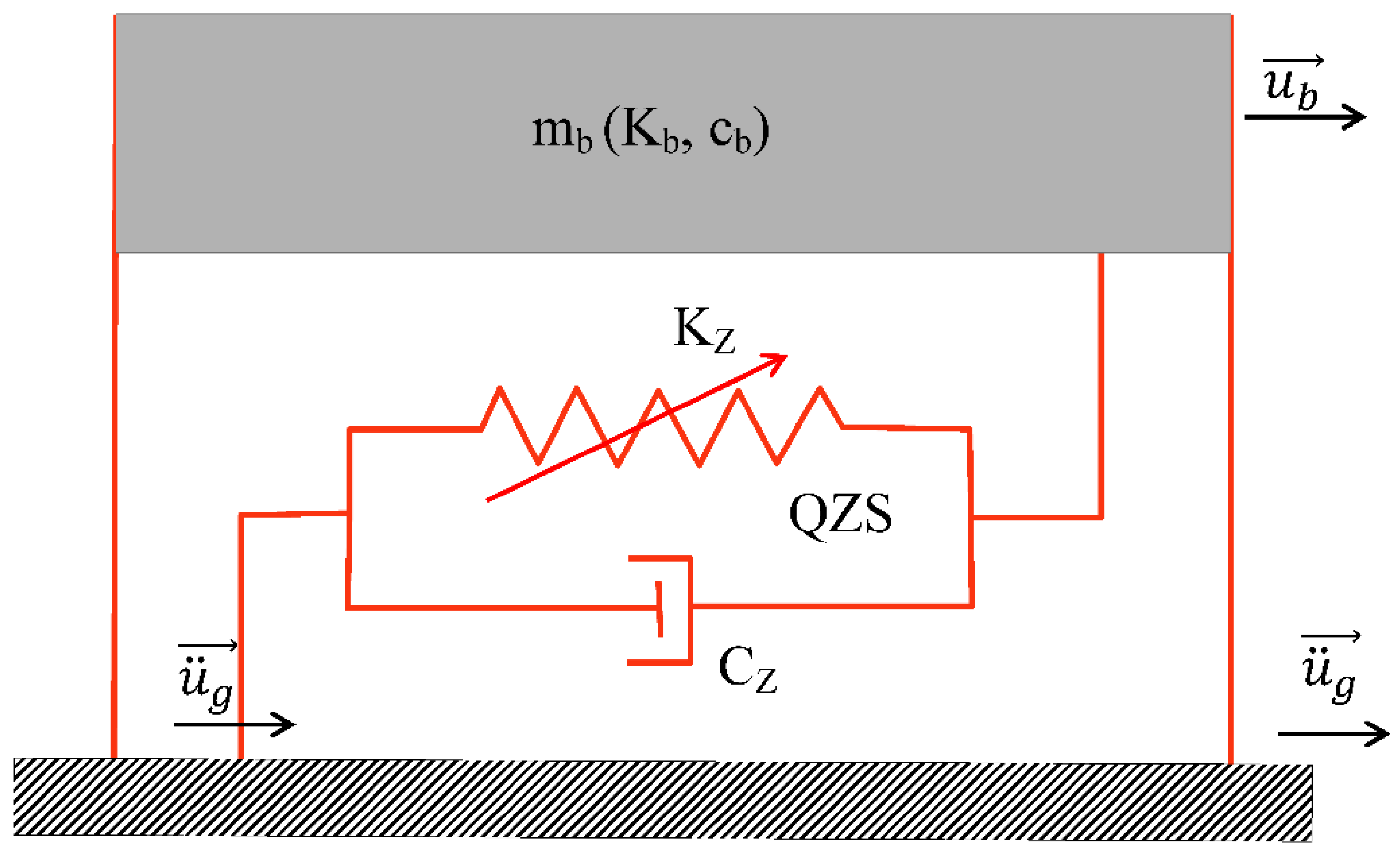
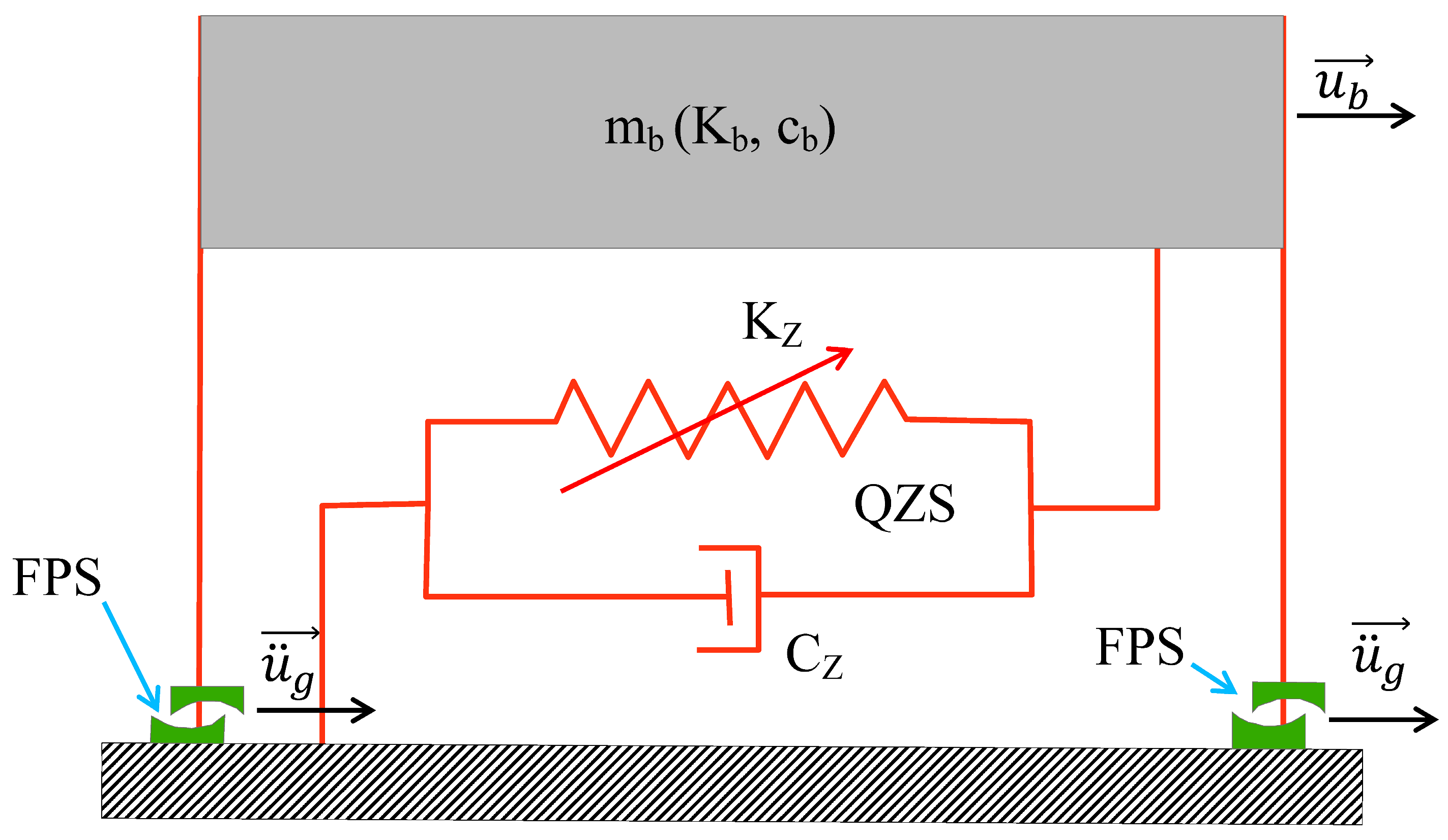

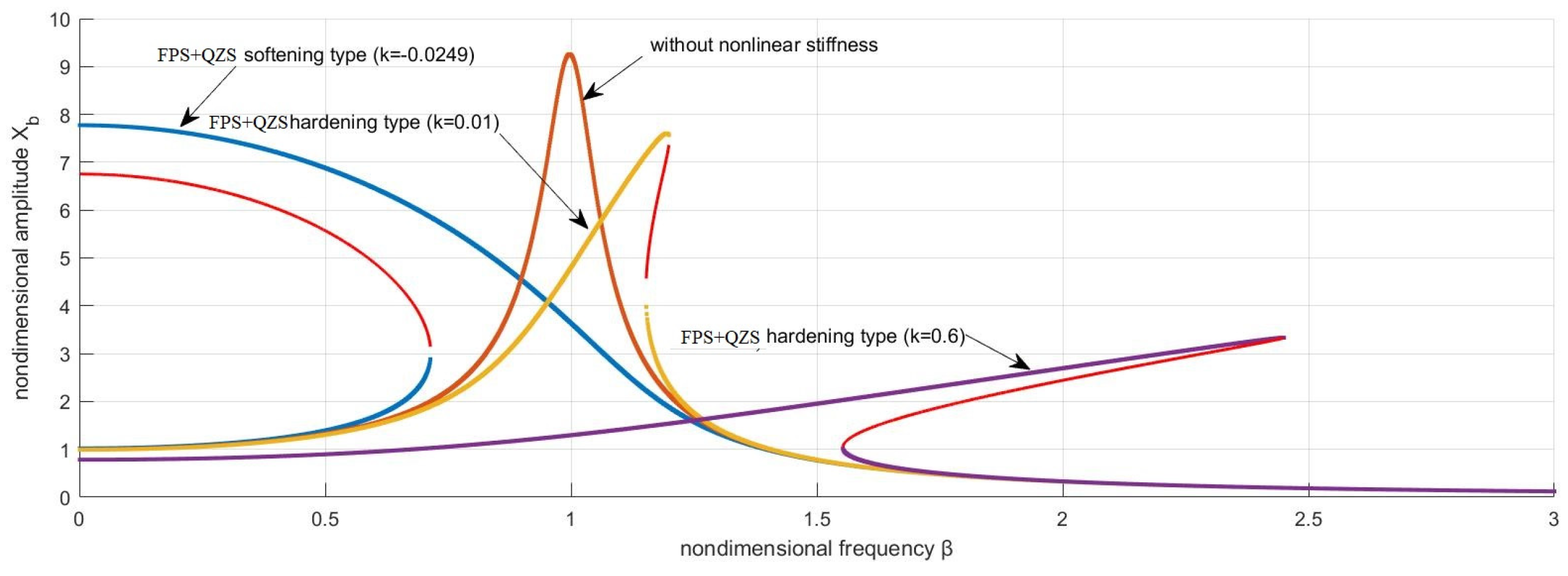
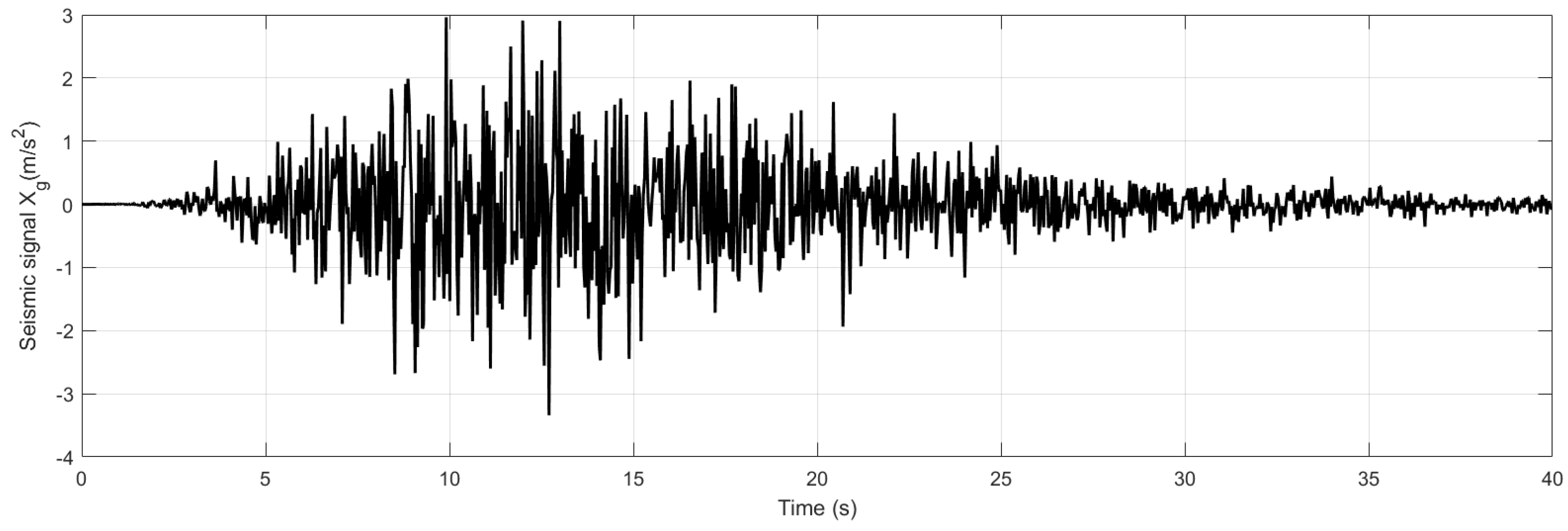

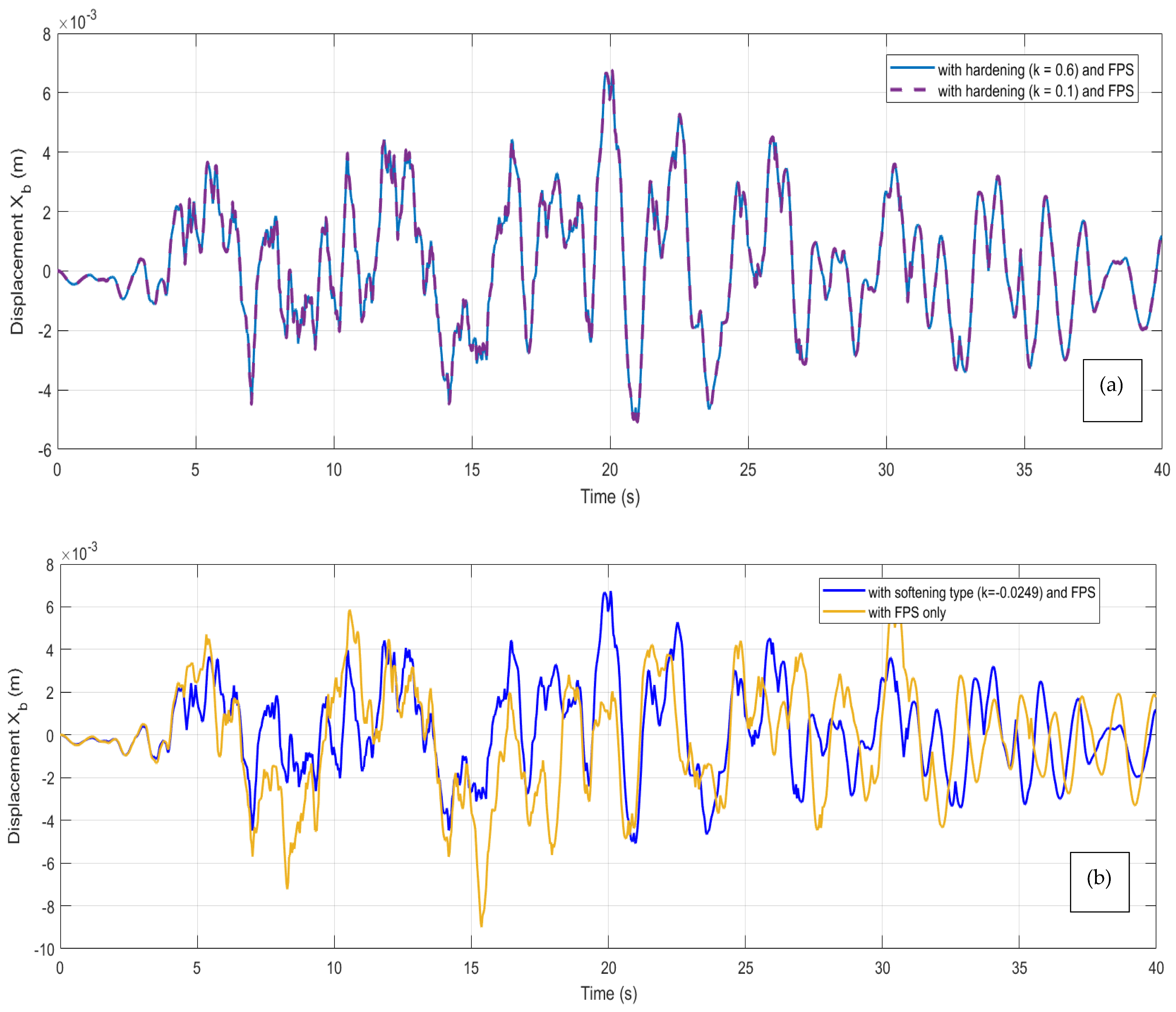
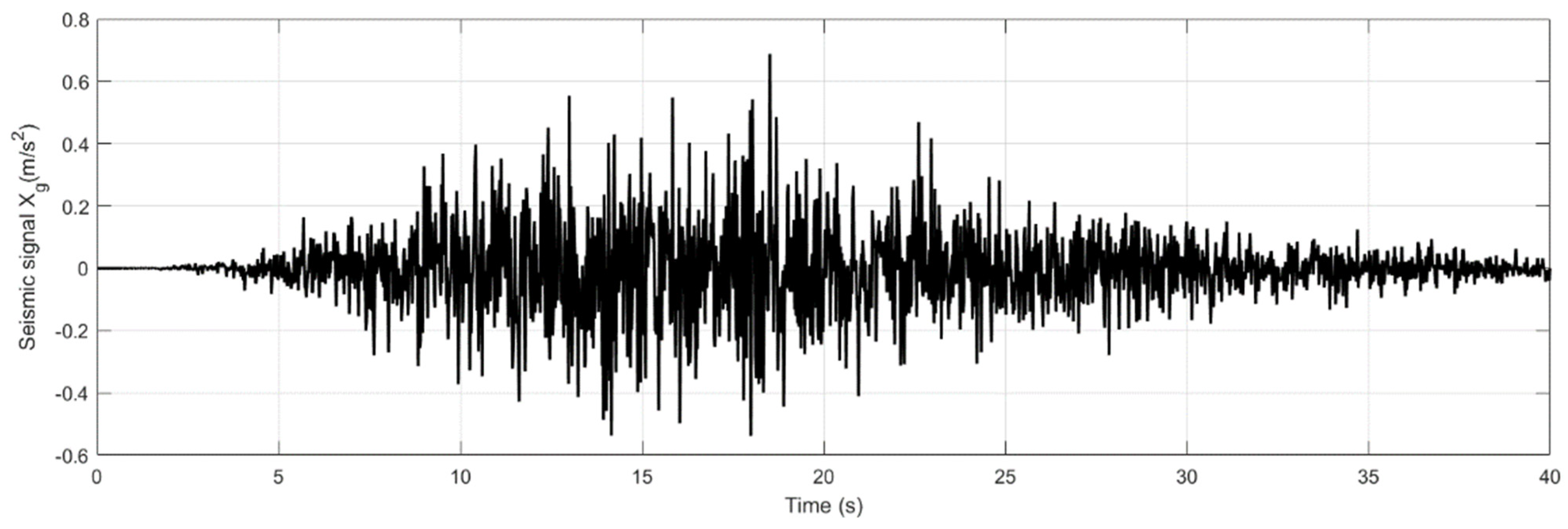
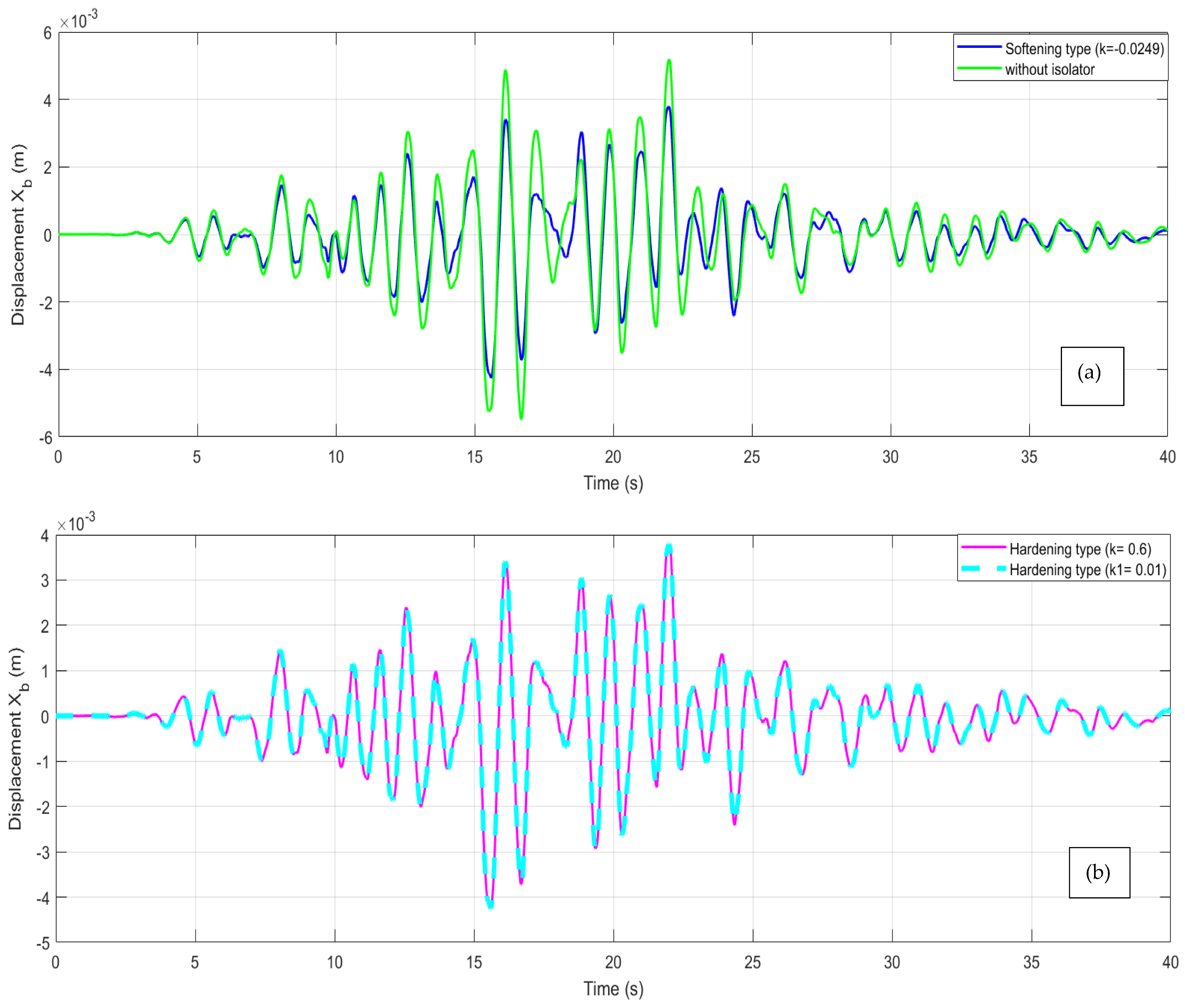
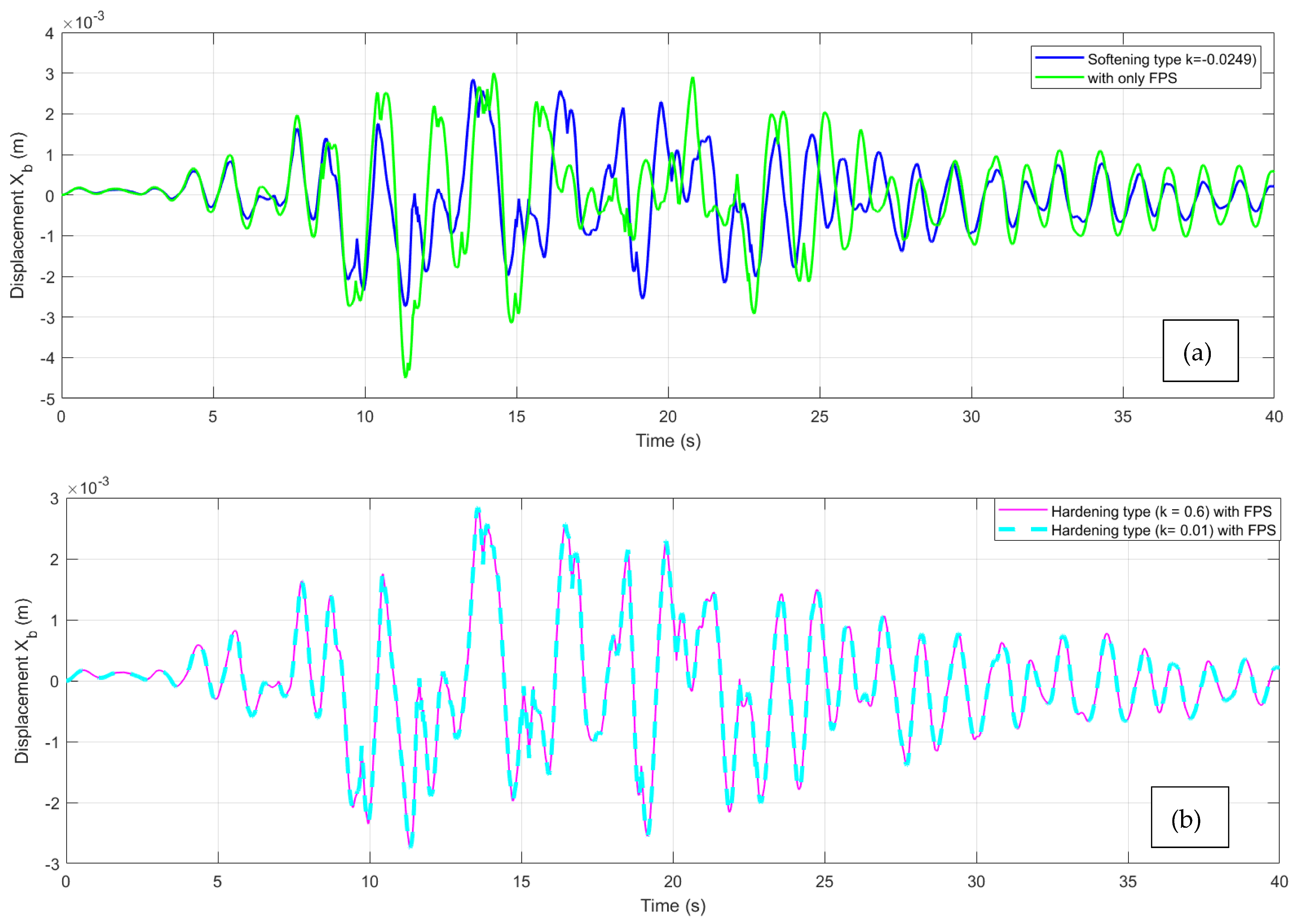
| Systems | Improvements | Reference |
|---|---|---|
| NS–TMD | Improves the stability of a bridge previously equipped with FPS. Reduces vibration with a maximum output amplitude of 0.081 m. | [25] |
| FPSIS | Reduces vibrations with a maximum amplitude of 0.8 m. | [27] |
| NS–FPS | Presents an innovative solution to improve the seismic resilience of above-ground buildings and underground infrastructures (ASUS) by coupling negative stiffness and friction pendulum. | [26] |
| FPS–TMD | Reduces vibration with a maximum amplitude of 0.1 m. | [27] |
Disclaimer/Publisher’s Note: The statements, opinions and data contained in all publications are solely those of the individual author(s) and contributor(s) and not of MDPI and/or the editor(s). MDPI and/or the editor(s) disclaim responsibility for any injury to people or property resulting from any ideas, methods, instructions or products referred to in the content. |
© 2025 by the authors. Licensee MDPI, Basel, Switzerland. This article is an open access article distributed under the terms and conditions of the Creative Commons Attribution (CC BY) license (https://creativecommons.org/licenses/by/4.0/).
Share and Cite
Wouako Wouako, R.K.; Tchato, S.C.; Kayo Pokam, E.F.; Gounou Pokam, B.P.; Pouth Nkoma, A.M.; Manguelle Dicoum, E.; Njandjock Nouck, P. Response of a Structure Isolated by a Coupled System Consisting of a QZS and FPS Under Horizontal Ground Excitation. Buildings 2025, 15, 1498. https://doi.org/10.3390/buildings15091498
Wouako Wouako RK, Tchato SC, Kayo Pokam EF, Gounou Pokam BP, Pouth Nkoma AM, Manguelle Dicoum E, Njandjock Nouck P. Response of a Structure Isolated by a Coupled System Consisting of a QZS and FPS Under Horizontal Ground Excitation. Buildings. 2025; 15(9):1498. https://doi.org/10.3390/buildings15091498
Chicago/Turabian StyleWouako Wouako, Richie Kevin, Sandra Céleste Tchato, Euloge Felix Kayo Pokam, Blaise Pascal Gounou Pokam, André Michel Pouth Nkoma, Eliezer Manguelle Dicoum, and Philippe Njandjock Nouck. 2025. "Response of a Structure Isolated by a Coupled System Consisting of a QZS and FPS Under Horizontal Ground Excitation" Buildings 15, no. 9: 1498. https://doi.org/10.3390/buildings15091498
APA StyleWouako Wouako, R. K., Tchato, S. C., Kayo Pokam, E. F., Gounou Pokam, B. P., Pouth Nkoma, A. M., Manguelle Dicoum, E., & Njandjock Nouck, P. (2025). Response of a Structure Isolated by a Coupled System Consisting of a QZS and FPS Under Horizontal Ground Excitation. Buildings, 15(9), 1498. https://doi.org/10.3390/buildings15091498





